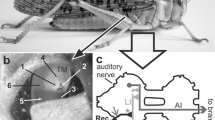Abstract
The tentacle withdrawal reflex of the terrestrial snail Helix aspersa was studied in vitro. The reflex is evoked by mechanical stimulation of the nose. Lesion experiments showed that 45% to 75% of the response amplitude is attributable to peripheral pathways alone. The central contribution increases with increasing stimulus intensity.
Repeated stimulation produced pure habituation at low stimulus strengths, and habituation mixed with intrinsic sensitization (warm-up effect) at high stimulus strengths. The simultaneous occurrence of habituation and sensitization is consistent with the dual process theory of plasticity. Additional results differentiate the two processes. Habituation can occur without the CNS, whereas intrinsic sensitization requires the CNS. Also, the two processes are differentially effective in their influences on response amplitude and duration: habituation is more effective in determining response amplitude, while sensitization is more effective in determining response duration.
Although the establishment of sensitization requires the CNS, 81% of the memory for intrinsic sensitization was localized to the periphery, by lesion experiments. Extrinsic sensitization, caused by stimulation of the medial lip nerve, had similar behavioural effects and a similar memory locus. Both types of sensitization appear to be caused by neuromuscular facilitation mediated by a central pathway.
Similar content being viewed by others
Abbreviations
- CNS :
-
central nervous system
- PNS :
-
peripheral nervous system
- S-R :
-
stimulus-response
- TRM :
-
tentacle retractor muscle
References
Appleton T, Wilkens JL (1990) Habituation, sensitization and the effect of serotonin on the eyestalk withdrawal reflex of Cancer magister. Comp Biochem Physiol A 97: 159–163
Balaban P (1994) Behavioral neurobiology of learning in terrestrial snails. Prog Neurobiol 41: 1–19
Carew TJ (1984) An introduction to cellular approaches used in the analysis of habituation and sensitization in Aplysia. In: Peeke HVS, Petrinovich L (eds) Habituation, sensitization, and behavior. Academic Press, Orlando, pp 205–249
Chase R (1981) Electrical responses of snail tentacle ganglion to stimulation of the epithelium with wind and odors. Comp Biochem Physiol A 70: 149–155
Chase R, Tolloczko B (1993) Tracing neural pathways in snail olfaction: From the tip of the tentacle to the brain and beyond. Microsc Res Tech 24: 214–230
Christoffersen GRJ, Frederiksen K, Johansen J, Kristensen BI, Simonsen L (1981) Behavioural modification of the optic tentacle of Helix pomatia; effect of puromycin, activity of S-100. Comp Biochem Physiol A 68: 611–624
Cottrell GA, Schot LPC, Dockray GJ (1983) Identification and probable role of a single neurone containing the neuropeptide Helix FMRFamide. Nature 304: 638–640
Davis M, File SE (1984) Intrinsic and extrinsic mechanisms of habituation and sensitization: Implications for the design and analysis of experiments. In: Peeke HVS, Petrinovich L (eds) Habituation, sensitization, and behavior. Academic Press, Orlando, pp 287–323
Frost WN, Clark GA, Kandel ER (1988) Parallel processing of short-term memory for sensitization in Aplysia. J Neurobiol 19: 297–334
Groves PM, Thompson RF (1970) Habituation: A dual process theory. Psychol Rev 77: 419–450
Hinde RA (1970) Behavioural habituation. In: Horn G, Hinde RA (eds) Short-term changes in neural activity and behaviour. Cambridge University Press, London pp 3–40
Lockery SR, Kristan WB (1991) Two forms of sensitization of the local bending reflex of the medicinal leech. J Comp Physiol A 168: 165–177
Lukowiak K, Jacklet J (1975) Habituation and dishabituation mediated by the peripheral and central neural circuits of the siphon of Aplysia. J Neurobiol 6: 183–200
Perlman AJ (1979) Central and peripheral control of siphon-withdrawal reflex in Aplysia californica. J Neurophysiol 42: 510–529
Thompson RF, Spencer WA (1966) Habituation: A model phenomenon for the study of neuronal substrates of behavior. Psychol Rev 73: 16–43
Zakharov IS, Balaban PM (1987) Neural mechanisms of age-dependent changes in avoidance behaviour of the snail Helix lucorum. Neuroscience 23: 721–729
Zakharov IS, Matz VN, Balaban PM (1982) Participation of the giant cerebral neuron in control of withdrawal behavior in the snail (in Russian). Neirophysiologiya 14: 353–358; Transl Neurophysiol 14: 262–266 (1983)
Author information
Authors and Affiliations
Rights and permissions
About this article
Cite this article
Prescott, S., Chase, R. Two types of plasticity in the tentacle withdrawal reflex of Helix aspersa are dissociated by tissue location and response measure. J Comp Physiol A 179, 407–414 (1996). https://doi.org/10.1007/BF00194994
Accepted:
Issue Date:
DOI: https://doi.org/10.1007/BF00194994




